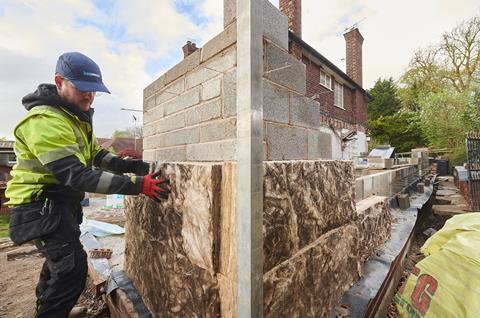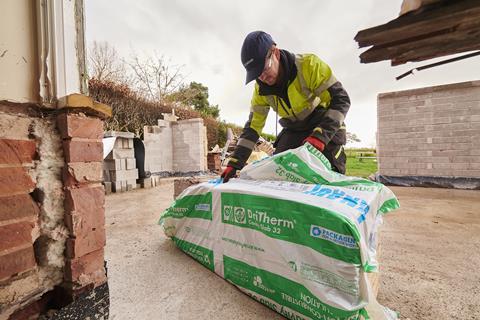As energy regulations tighten, more developers are making the move to 150mm wall cavities. Kelly Westwood, Head of Construction Projects for Knauf Insulation, looks at the benefits for architects designing with wider cavities in mind

The last two years have passed quickly, and the 2022 Approved Document L (Energy Efficiency) uplift still feels very recent, but the industry is already moving on at a pace. Next year, the Future Homes Standard (FHS) will be introduced, and there will be a 75% reduction in operational carbon for new homes compared with 2013 standards.
The housing sector needs to move quickly to keep up, and we already see signs of change. For example, a survey of housebuilders revealed that 150mm wall cavities are becoming the new industry norm, with 41% of participants already having made the switch for new homes and over a quarter considering it. Given the rapidly evolving regulatory landscape, this is hardly a surprise. Designing with wider cavities gives you greater flexibility to choose materials that deliver the thermal performance and carbon reduction new homes need.

Thermal performance under scrutiny
The pressure on architects to meet stringent energy efficiency requirements is intensifying. Approved Document L has introduced tighter limiting U-values, and the FHS consultation has proposed recognising developers who performance test their homes post-occupancy. Although this is not yet confirmed, it shows a direction of travel towards in-use measurement. Homes increasingly need to perform in the real world, not just on paper, and bridging that gap can be challenging.
For example, poorly installed insulation may not achieve the thermal performance it was specified to deliver. Rigid board insulation is particularly prone to this because it will not sit flush against a cavity unless it is perfectly flat, which is rare. It also needs to be precisely cut and taped, allowing more opportunity for human error. This can lead to air gaps, which compromise thermal performance. A study into thermal looping in cavity walls partially filled with insulation boards showed that a 6mm gap is enough to cause an increase in heat transfer of 158%. As in-use energy measurement becomes more widely used, this discrepancy between designed and actual performance will become more evident.
However, 150mm cavities offer a solution. They allow for the use of mineral wool insulation, such as Knauf Insulation’s DriTherm® Cavity Slab 32, which is easier to install correctly under real-world conditions. Mineral wool is a flexible material that adapts to minor imperfections in the substrate, fully filling the cavity. Its strands also ‘knit’ together, minimising gaps and maximising thermal performance.
Lower whole-life carbon

Current regulations focus on reducing operational carbon emissions from homes, but attention is moving towards whole-life carbon. This includes the emissions released throughout the building lifecycle, from manufacturing the products used to build them to deconstruction at the end of their life. Industry bodies are already supporting a proposed Part Z Building Regulation, which calls for measuring and reporting whole-life carbon emissions for certain construction projects by 2026.
Architects play a critical role in decarbonising new homes by choosing the products that go into them. Glass mineral wool has the lowest levels of embodied carbon of any mainstream insulation material, helping to reduce a home’s whole-life carbon. As regulations evolve, designing with 150mm cavities will enable you to specify lower-carbon products like glass mineral wool. In contrast, narrower cavities may limit you to using insulation with a higher environmental impact.
Improved fire safety
Alongside energy efficiency and carbon reduction, fire safety regulations are also tightening. This is another area where specification plays a key role, and designing with wider cavities provides flexibility. In 2022, Approved Document B (Fire Safety) was updated further to restrict the use of combustible materials in certain buildings, but many developers are choosing to go beyond those minimum requirements. London Plan guidance, for example, now states that major development proposals must be submitted with a Fire Statement confirming that no combustible materials will be incorporated into the development’s external walls. Future regulations will likely limit the use of combustible materials even further, so designing with non-combustible products now helps to futureproof developments. Again, a 150mm cavity allows you to specify products like DriTherm® Cavity Slab 32 glass mineral wool insulation, which is non-combustible with a Euroclass A1 reaction to fire classification.

Keep your options open
Besides performance, it is also worth considering product availability. As fossil fuel use decreases, the availability of petrochemical-based materials may become uncertain, potentially leading to a more volatile market. A wider cavity offers developers a broader range of products to source from should supply chain issues arise.
Incorporating 150mm cavities is a strategic decision that addresses current and future requirements while maintaining design flexibility. By understanding and utilising the benefits of wider cavities, architects can deliver homes that meet the highest standards of performance, safety, and sustainability.
Learn more about the latest regulatory updates at Knauf Insulation’s Housebuilders Hub.














